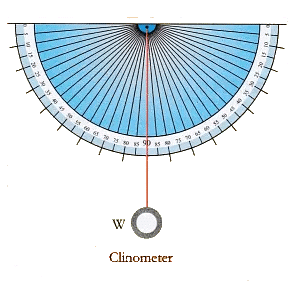Class 10 Exam > Class 10 Notes > Lab Manuals for Class 10 > Lab Manual: Making of a Clinometer
Lab Manual: Making of a Clinometer | Lab Manuals for Class 10 PDF Download
Objective
To make a mathematical instrument ‘clinometer’ to measure the height of a distant object.Prerequisite Knowledge
- Concept of angle of elevation and depression.
- Properties of right-angled triangle.
Materials Required
Small pipe or drinking straw, a wooden board, wooden strip, thread, weight, screw, geometry box, etc.
Procedure
- Prepare a semi-circular protractor with the help of geometry box. Mark degrees in sexagesimal scale with 0° at the lowest and 10 to 90° proceeding both clockwise and anti-clockwise.
- Fix a hollow pipe along the diameter of it fig. (i).
- Punch a whole at the centre of a semicircle.
- Suspend a weight (w) from a small nail fixed to the centre.
- Ensure that the weight at the end of the string hangs below the protractor.

Determining the Height of an Object:
- Measure the distance of the object from you. Let it is d.
- Look through the hollow pipe straw at the top of the object by rotating it gradually. Make sure that you can clearly see the top of the object.
- Hold the clinometer steady and record the angle which the string makes on the scale of the clinometer. This angle is the required angle of elevation , let be θ .
Using trigonometric ratio:
tan θ = height / distance = h/d
h=d.tan θ
Observation
- angle of elevation 0.
- distance between object and clinometer d.
- height of clinometer/(let)
Therefore height of object = l + h = l + dtanθ
Result
Angle of elevation can be found easily.
Learning Outcome
Students learn how to determine the angle of elevation of an object by clinometer and use of it to determine the height of an object at a known distance.
Activity Time
- If the height of clinometer is 3 m, distance between object and clinometer is 27 m and angle of elevation is 45°. What is the height of an object?
- A kite is flying at a height of 40√3 metre from the ground level, attached to a string inclined at 60° to the horizontal. What is the length of the string?
The document Lab Manual: Making of a Clinometer | Lab Manuals for Class 10 is a part of the Class 10 Course Lab Manuals for Class 10.
All you need of Class 10 at this link: Class 10
FAQs on Lab Manual: Making of a Clinometer - Lab Manuals for Class 10
| 1. How does a clinometer work? |  |
Ans. A clinometer is a simple tool used to measure angles of inclination or elevation. It consists of a protractor-like scale and a sight, which is aligned with the object being measured. By looking through the sight and reading the angle on the scale, the clinometer allows us to determine the angle accurately.
| 2. Can a clinometer be used to measure the height of a building? |  |
Ans. Yes, a clinometer can be used to measure the height of a building or any tall object. By standing at a known distance away from the building and measuring the angle of elevation from the ground to the top of the building, we can use trigonometric principles to calculate the height of the building.
| 3. How can I make a clinometer at home? |  |
Ans. To make a clinometer at home, you will need a protractor, a straw or a small tube, a weight (such as a washer or a small object), and a string. Attach the string to the weight and thread it through the straw or tube. Attach the protractor to the straw or tube, ensuring it can rotate freely. Calibrate your clinometer by setting it up at a known angle and marking the corresponding angle on the protractor. Your homemade clinometer is now ready to use.
| 4. What are some practical uses of a clinometer? |  |
Ans. Clinometers have various practical uses. They can be used in construction and engineering to measure the slope of land or the angle of a roof. They are also used in navigation to determine the angle of elevation of celestial bodies for celestial navigation. Additionally, they are used in surveying to measure heights and distances.
| 5. Can a clinometer be used for measuring angles on a flat surface? |  |
Ans. While a clinometer is primarily used for measuring angles of inclination or elevation, it can also be used to measure angles on a flat surface. By aligning the clinometer with the desired angle and reading the angle on the scale, it allows for accurate measurements on both inclined and flat surfaces. However, it is important to note that clinometers are more commonly used for measuring vertical angles.
Related Searches
























